AI Helps in Landmark Solar Observation in Research Conducted at University of Graz and Skoltech
In a landmark achievement for astrophysics, a team of international researchers led by the University of Graz, in partnership with Russia’s Skolkovo Institute of Science and Technology (Skoltech) and the High Altitude Observatory in the United States, has developed an advanced artificial intelligence (AI) framework that transforms decades-old solar observations into high-resolution imagery. This deep learning method, known as Instrument-to-Instrument Translation (ITI), uses generative adversarial networks (GANs) to harmonize historical data with cutting-edge modern observations. The result is a more complete and consistent picture of our Sun’s behavior over time, unlocking new scientific insights from legacy datasets.
A Longstanding Challenge in Solar Observation
Observing the Sun has always been a central focus of astronomical study, but inconsistencies between past and present instruments have limited scientists' ability to track long-term changes.
Legacy datasets, some spanning over two decades, often suffer from limitations in resolution, calibration, and noise contamination. Newer solar missions, though sophisticated, cannot fill the historical gaps. This mismatch has hampered the ability to study rare phenomena and solar cycles in a continuous and coherent manner.
The ITI framework addresses this by enabling seamless translation of images between instruments — even those that never overlapped operationally — bringing uniformity and clarity to disparate data sources.
How AI Reconstructs Solar History
At the core of this innovation lies a novel application of generative adversarial networks (GANs), a class of AI algorithms that use two neural networks in tandem: one simulates degraded images from high-quality originals, while the other learns to reverse this degradation process.
This dual-network system is trained on real-world solar imagery, allowing it to understand and replicate the complex differences between instruments. Once trained, the model can transform older, lower-quality images into high-fidelity counterparts that resemble the latest data, all while preserving the scientific accuracy of physical solar features.
Applications Across the Solar Data Spectrum
The impact of this deep learning framework extends across a diverse range of solar data challenges:
Combining 24 Years of Observations: ITI integrates data from multiple solar missions into a coherent sequence, supporting research into multi-decade solar trends.
Full-Disk Image Enhancement: The resolution of full-disk solar imagery has been significantly improved, providing more granular details of surface and atmospheric activity.
Noise Reduction for Ground-Based Observations: Atmospheric distortion, a common issue with ground-based solar telescopes, is minimized, increasing the utility of such datasets.
Far-Side Magnetic Field Estimation: The model extrapolates magnetic field activity on the Sun’s far side — a region not directly visible — using only extreme ultraviolet data.
Scientific and Computational Impact
Lead author Robert Jarolim, a NASA postdoctoral fellow, emphasized that while AI does not replace physical observations, it enables scientists to extract more value from the data that already exists. The capacity to repurpose decades-old observations to match modern standards opens doors to new scientific inquiries and enhances the reliability of long-term solar studies.
Tatiana Podladchikova, an associate professor at Skoltech, further underlined the transformative nature of the project: “We’re creating a universal language to study the Sun’s evolution across time.” The Skoltech high-performance computing infrastructure played a pivotal role in training the models that now reveal previously hidden correlations within solar cycles.
Building the Future of Solar Research
Beyond the scientific breakthrough, this project reflects a broader shift toward interdisciplinary, AI-powered science. By leveraging high-performance computation and cutting-edge machine learning techniques, researchers are not only preserving historical data but enhancing its scientific relevance.
Every past solar observation can now contribute to modern research with the same clarity as present-day data. This democratization of scientific data provides a foundation for further discoveries and a richer understanding of the Sun’s impact on our solar system — particularly crucial for space weather prediction, satellite operations, and climate modeling.
Skoltech's Role in Scientific Innovation
Skoltech, founded in collaboration with MIT in 2011, continues to position itself as a leader in high-impact research and technology innovation. Ranked No. 1 in Russia for computer science by the SCImago Institutions Rankings and recognized globally by the Nature Index, the institute channels its expertise across artificial intelligence, quantum technologies, and advanced engineering to solve real-world challenges.
In this AI-driven solar project, Skoltech has provided not only computational horsepower but intellectual leadership, pushing the boundaries of what is possible in modern astrophysics and space sciences.
Conclusion: A Bright Horizon for Solar Data
The integration of AI into solar observation represents a turning point for astrophysical research. The Instrument-to-Instrument Translation (ITI) framework allows scientists to transcend temporal and technical boundaries, unifying decades of data into a coherent whole.
